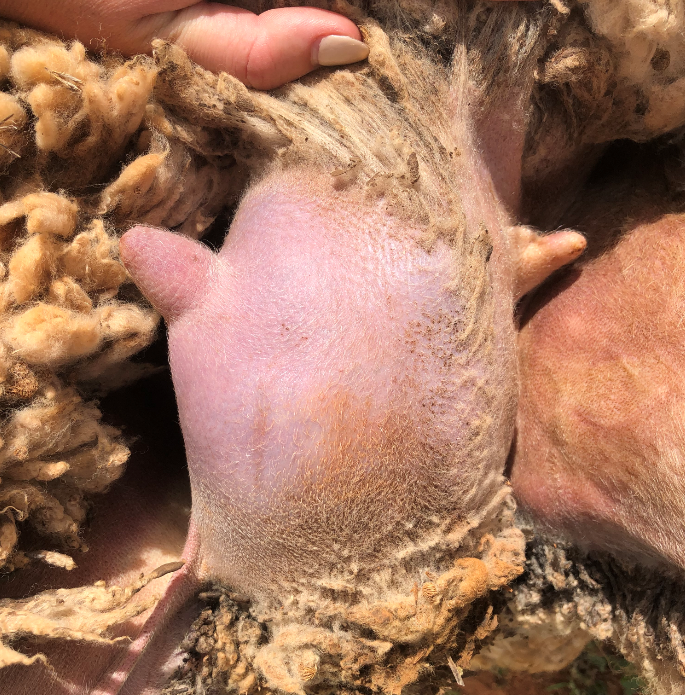Mastitis in sheep - a case study
 PRODUCTION ADVICE - JUNE 2021 - ANIMAL BIOSECURITY & WELFARE
PRODUCTION ADVICE - JUNE 2021 - ANIMAL BIOSECURITY & WELFARE
By Mark Corrigan
District Veterinarian
P: 02 6051 2208 | M: 0428 256 431 | E: mark.corrigan@lls.nsw.gov.au
 Recently, a local lamb producer reported some losses in crossbred ewes post-lambing and suspected mastitis. He described that the ewes would become lethargic (sluggish and dull) and depressed, with enlarged, hard, blue udders. He undertook antibiotic treatment, with some ewes surviving. The ewes were at pasture but had access to self-feeders.
Recently, a local lamb producer reported some losses in crossbred ewes post-lambing and suspected mastitis. He described that the ewes would become lethargic (sluggish and dull) and depressed, with enlarged, hard, blue udders. He undertook antibiotic treatment, with some ewes surviving. The ewes were at pasture but had access to self-feeders.
Clinical examination
On examination of one ewe, the udder was swollen and warm, with an area of blue-black discolouration, a result of reduced blood supply and hence the name ‘black’ or ‘blue’ mastitis.
The other ewe was not as severely affected, but the udder was still enlarged, lumpy and hard, as a result of scarring and abscess formation from chronic infection.
Milk from the affected glands was pale pink and watery in both ewes. Milk samples were submitted to the lab for culture, and a pure growth of Mannheimia haemolytica was grown, a common bacterial cause of mastitis.
What is mastitis?
Mastitis is an inflammation of the mammary gland, predominantly caused by bacteria infecting the udder tissue. This most commonly occurs at lambing and throughout the lactation, particularly at weaning when there is no milk movement in the udder. Teat damage, such as a wound or scabby mouth infection, can also predispose ewes to mastitis. If the mastitis is severe enough, it will cause septicaemia (blood poisoning) and death.
The two main bacteria that cause mastitis in sheep are Staphlococcus aureus and Mannheimia (Pasteurella) haemolytica, but there are others. These bacteria can be a normal inhabitant of the sheep or picked up from the environment, which tends to happen more readily if sheep are camping in a spot heavily contaminated with faeces.
Mannheimia haemolytica can also cause pneumonia in sheep, which can then manifest as mastitis if the bacteria are passed to the udder from an infected suckling lamb.
Production effects
Mastitis can lead to poor growth of lambs or lamb losses due to a reduced quantity and quality of milk and the fact that lambs may not be allowed to feed if the ewe’s udder is painful.
Generally, the mammary gland affected by mastitis will not resume normal function. Black mastitis and severe clinical mastitis will often result in affected ewes being culled at the end of the lactation, assuming they survive the disease.
If affected ewes are retained for the following lactation, there may be only one functioning side of the udder, which is detrimental to the lambs, especially in a ewe trying to feed twins or triplets.
Mastitis prevalence
Minimal work had been done on the prevalence of mastitis in Australia, but there appears to be a greater incidence in meat-breed sheep compared with merinos. Outbreaks have been known to cause clinical cases in 20-30 per cent of the lambing mob.
Risks factors for developing mastitis include:
- Teat injuries
- Older (> 4-year-old) ewes
- Multiple progeny
- Poor nutrition
- Previous history mastitis and/or genetic susceptibility
- Increased stock density and common feeding source
- Cool and damp environment
- Poor udder confirmation
- Other infected animals close by.
Treatment and prevention
Managing mastitis in the face of an outbreak can be quite challenging and is not often feasible. Ideally, affected ewes should be identified, treated with systemic antibiotics and then separated from the main flock to prevent transmission to other ewes. While treatment may reduce mortality rates, damage to the udder is often irreversible and will result in reduced productivity in subsequent lactations. Ewes’ udders should be palpated post-lactation and prior to the next lambing, and ewes with abnormal udders should be culled.
It’s important to provide good ewe nutrition and a clean lambing paddock to reduce the incidence of mastitis. In the case above, the producer used automatic feeders to compensate for the energy gap from average pastures due to the dry early autumn. This may have increased the risk of mastitis, but the producer needed to continue to provide the appropriate nutrition.
Management decisions can be difficult sometimes as a decision to fix one problem may create another. Therefore, you need to find a balance between solution and risk that is most appropriate to your operation.